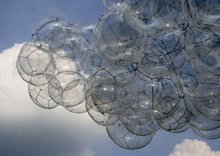Tomas Saraceno
dal 17/11/2007 al 16/2/2008
Segnalato da
17/11/2007
Tomas Saraceno
Berkeley Art Museum and Pacific Film Archive BAM/PFA, Berkeley
Microscale, Macroscale, and Beyond: Large-Scale Implications of Small-Scale Experiments. The artist uses practical principles from engineering, physics, chemistry, aeronautics, and architecture to experiment and re-think the way we live in relation to one another. He works regularly with materials otherwise unknown outside of the scientific community, such as aerogel, a sponge-like insulating substance developed for use in the aerospace industry.

curated by Elizabeth Thomas
Exhibition gives an unprecedented view of an artist who re-envisions our relationship to inhabitable space.
Berkeley, CA, November 7, 2007 — The University of California, Berkeley Art Museum and Pacific Film Archive (BAM/PFA) presents Tomás Saraceno: Microscale, Macroscale, and Beyond: Large-Scale Implications of Small-Scale Experiments, an exhibition featuring the visionary installations and photographs of Argentine artist Tomás Saraceno, who currently lives and works in Frankfurt. The exhibition marks Saraceno's first solo show in the U.S., giving Bay Area audiences a unique opportunity to view the work of an artist who fuses contemporary art with architectural theory and scientific research. The exhibition, which is part of BAM/PFA's acclaimed MATRIX Program for Contemporary Art, features photographs, small-scale sculptures, and a large-scale installation created specifically for the Berkeley Art Museum. Tomás Saraceno: Microscale, Macroscale, and Beyond: Large-Scale Implications of Small-Scale Experiments opens November 18, 2007 and runs through February 17, 2008.
Saraceno uses practical principles from engineering, physics, chemistry, aeronautics, and architecture to experiment and re-think the way we live in relation to one another. He works regularly with materials otherwise unknown outside of the scientific community, such as aerogel, a sponge-like insulating substance developed for use in the aerospace industry. Its incredibly light weight (only three times that of air itself) and strong structural properties make it an ideal potential building material for Saraceno to exemplify his vision of the future, which is perhaps best embodied in the ongoing project Air-Port-City. Air-Port-City envisions networks of habitable structures that float in the air. The freedom of their airborne location allows these sections of living space, organized within a modular cellular framework, to join together like clouds, creating aerial cities in constant physical transformation. Saraceno describes these kinds of structures as capable of embodying more elastic and dynamic rules related to political, geographical, and cultural borders.
On the microscale, Saraceno experiments with properties of suspension and soap film structures, creating devices that demonstrate the feasibility of his utopian ideas. For the Berkeley Art Museum, Saraceno will create a site-specific installation from his series Flying Garden, filled with Tillandsias and Spanish moss, plants that derive their nutrients from the air. Conceptually, this air-sufficient agricultural model serves as an accompaniment to other platforms for habitation or play, but also suggests the human self-sufficiency that his project envisions.
Saraceno continues the tradition of visionary architects before him, including Buckminster Fuller, Frei Otto, Archigram, and the Ant Farm Collective. But his project is equally informed by the present moment—reflecting a consciousness about waste and conservation, striving for a harmonic balance between mediated and natural worlds, and acknowledging the interdependence of individuals to one another.
A respect for nature is especially evident in Saraceno's photographs, which range from expansive views of the world's largest salt lake, Solar de Uyuni in the Bolivian Andes, to extreme close-ups of natural phenomena like water droplets gathering on a spider web. Though exceptionally beautiful, they also poetically suggest Saraceno's vision for future models of habitation: the images of the extremely reflective salt lake create the illusion of a great, never-ending plain of sky and clouds, while the spider web possesses a flexible strength mirrored in the netlike structure of Air-Port-City, with its constellation of cellular bubbles.
Saraceno was born in Argentina in 1973 and studied architecture at the Universidad Nacional de Buenos Aires. He continued postgraduate studies in art and architecture at Escuela Superior de Bellas Artes Ernesto de la Carcova, Buenos Aires, and Staatliche Hochschule für Bildende Kunst in Frankfurt, Germany, where he currently lives and works.
Public Program
Artist's Talk
Sunday, November 18, 3:30p.m.
Gallery 1
Reception follows
Phyllis Wattis MATRIX Curator Elizabeth Thomas will join Tomás Saraceno for an in-gallery discussion of his current project.
The MATRIX Program at the UC Berkeley Art Museum is made possible by a generous endowment gift from Phyllis C. Wattis.
Additional donors to the MATRIX Program include the UAM Council MATRIX Endowment, Joachim and Nancy Bechtle, Maryellen and Frank Herringer, Noel and Penny Nellis, Paul L. Wattis III, and
Iris Shimada.
Press contact: Jonathan Knapp jlknapp@berkeley.edu
BAM/PFA
2626 Bancroft Way - Berkeley
Gallery Hours:
Wednesday and Friday to Sunday, 11 to 5; Thursday 11 to 7.
Closed Monday and Tuesday.
Admission: General admission $8; seniors and students 12-18 years $5; BAM/PFA members, UC Berkeley students, staff and faculty, and children under 12 free; group tour member $3 (to arrange a group tour, call (510) 642-5188). Admission is free on the first Thursday of each month.



